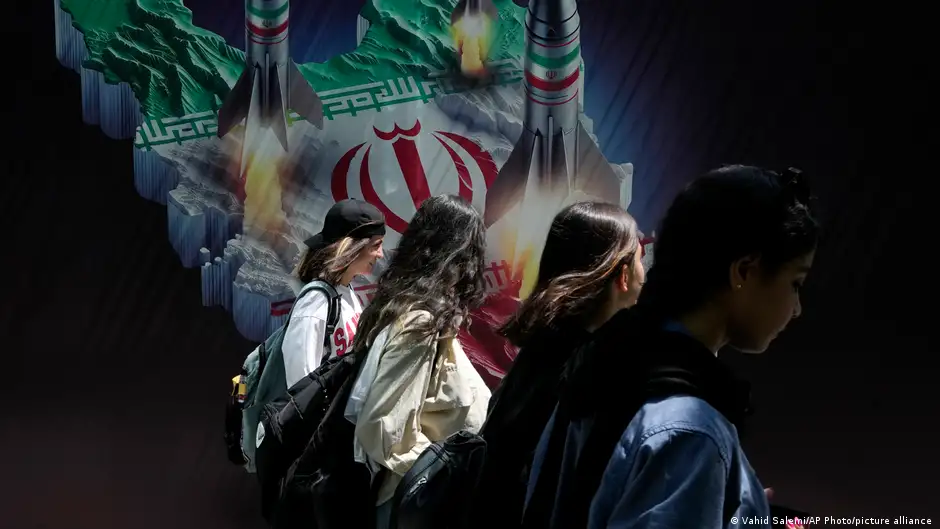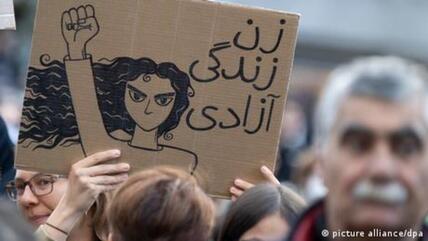Ehtesham-Zadeh and the inner revolution

It's early morning in Tehran, and a young woman is sitting in front of the mirror looking at her body, admiring herself. Not out of narcissism, but in order to set eyes on what she is about to envelop, piece by piece, to comply with the clothing regulations set by the Islamic Republic's regime. Incidentally, she is also making plans to meet up with some other young women in the early afternoon.
They will gather in Laleh Park, in the city centre, and film each other taking off their hijabs. They will stream this live online, hoping that they won't get caught by the omnipresent morality police – unlike a few months previously, when Mahsa Amini was murdered by its officers.
Suzi Ehtesham-Zadeh uses real-life material for this short story: if you followed the online activity of demonstrators at the start of the multifaceted "Zan, Zendegi, Azadi" (woman, life, freedom) protests, you will recall these scenes, which happened exactly as she describes.
The insults thrown by passing men – but also the applause and support from other people in the park, the astonished stares of playing children, who have never known a woman to lift her veil outside their own four walls.
You might think that Suzi Ehtesham-Zadeh's story collection is a reaction to recent events in Iran, where Ehtesham-Zadeh grew up, before moving to the USA to study English and creative writing. The stories were published in June by Dzanc Books in the U.S., with the significant title Zan, after many years in which the author's texts had appeared in various journals and anthologies.
In fact, only a small number of the sixteen stories were written in the past year; most are older. But they all carry within them the events that took place after the death of Jina Mahsa Amini in September 2022, a kind of seething beneath the surface that was always bound to erupt in what may well be the largest rebellion to date against a regime of old men who are clinging to power. Polls suggest that more than eighty per cent of the population are now against the regime.
Ehtesham-Zadeh was born in Washington, but her family moved to Iran when she was still very young. Growing up in Tehran, studying in Stanford and Boston – and in the midst of all this came the Islamic Revolution. Like so many people at the time, Ehtesham-Zadeh returned to Iran after the Shah was toppled in the hope of a fresh start that would bring democracy (or socialism, which is also a consideration for large sections of the current opposition in Iran).
On shaky ground
But as we know, there was no fresh start, only new repression. Just weeks after his return from exile in Paris in 1979, Ayatollah Khomeini revealed himself to be a despot. People might have known this, had they read his books and taken them seriously – but as so often, hope was wearing blinkers.
What followed was the now-familiar programme: censorship, dispossession, the end of fundamental rights, the oppression of women, minorities and opposition parties, mass arrests, torture. Ehtesham-Zadeh gives a first-hand description of this period from the perspective of a young woman whose parents live in the wealthy north of Tehran. They don't take part in the demonstrations that bring down the Shah, and afterwards they follow the unfolding events with horror, until their daughter's boyfriend is arrested and taken to the still-notorious Evin Prison, and she throws in the towel and leaves for the USA.
Zan also tells of women living in U.S. exile. Ehtesham-Zadeh's stories are strongest when she takes us into the inner lives of her characters, who may have got used to the life and the freedoms a democratic country affords, but are still at odds with themselves: because they are giving their children an overly American upbringing; because they themselves are starting to forget their Persian; because they have lost contact with relatives and friends; because the people they know in America have a completely skewed picture of Iran, shaped by the mass media; because their partners exoticize them without really taking any interest in their background – and much more. On the one hand, these are strong women, and on the other, they are people constantly searching for themselves, for a stable identity that seems to have been lost.
False bottoms and multiple sides
The story "Coming out, Going under" focuses on an Iranian student who acquires a female partner in the USA and doesn't know how to make her conservative family back home understand her situation. Another story depicts the gruelling existence of a young Afghan woman who has fled from Iran to Greece, and the constant fear that shapes everyday life in one of the miserable camps on the outer borders of the EU. It also provides an insight into the difficult situation for minorities in Iran, who are a constant political football for populists.
In "The Baboon", the protagonist and her American partner travel to Tehran to visit her family, where her grandfather tells a highly symbolic story that leaves not only the characters but also the reader feeling ambivalent: what is the old man trying to say? That he doesn't think much of the young American? That life can be cruel? Or something else entirely? And why does he then offer Abe the opium pipe, in a kind of welcome into the family?
Many of the stories here have false bottoms and multiple sides. And yet Suzi Ehtesham-Zadeh also manages to bring her characters and their surroundings vividly to life with a lightness of touch and her wonderfully clear prose style. At the same time, she refuses to be unambiguous, and the way portrays the women in her stories makes them seem more human than literary characters often do.

"The notion of home is bound up with loss"
Iranian-German author and filmmaker Siba Shakib was born in Tehran. Her best-selling novels deal with themes of heritage and the past. She speaks to Qantara.de about her new novel "Der Kirschbaum, den sie ihrer Mutter nie schenkte" (The Cherry Tree She Never Gave Her Mother), home, religion and the identity politics debate. Interview conducted by Schayan Riaz
Occasionally, you get the sense that a passage is too essayistic, that she is trying too hard to meet readers who know nothing about Iran where they stand. She explains historical and political developments, cultural practices and quirks, and rules and laws in present-day Iran. But it's hard to paint that as a weakness of the book.
A lot of Iranian literature assumes a great deal of prior knowledge, merely making a passing reference to historical events, for example, and expecting readers to pick up on the allusion. And of course, this makes it difficult for a readership who is less familiar with the country to access these books. Here, the opposite is true: access is as easy as it could be, and situations, contexts and backgrounds can be understood at once, without any superficiality or generalisations creeping in. All the crucial details are brightly illuminated. The book is worth reading not least for this reason, and is surely ripe for translation into German (something that I for one would recommend).
If you want to understand what is currently happening in Iran, and the causes and background to the political and social situation there; if you want to see what that does to the people affected; and if, on top of that, you want to read some outstanding prose, then this is the book for you.
© Qantara.de 2024
Translated from the German by Ruth Martin
